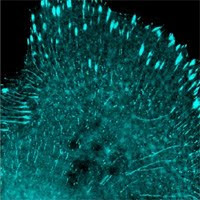Single Domain antibodies (VHH fragments, nanobodies, or as we call them, nAbs)
have been generated by injecting llamas with ligand-bound GPCR for the
purpose of obtaining crystals of active-state structures. Such
structural information could be critical in understanding drug functions
and screening for new drugs. The unique ability of VHH fragments to
fit into protein-protein complex crevices and hold proteins together was
demonstrated by two Nature publications from Brian Kobilka’s group at
Stanford ([1, 2], also see Allele Newsletter of Sep 4th, 2013). The nano antibody used in those studies, Nb80, showed affinity towards only the active state of the target GPCR.
However,
even with an antibody as great as Nb80, the authors were only able to
co-crystal GPCR beta2-adrenoceptor (b2AR) with high affinity agonists,
not its natural agonists such as adrenaline. In yet another Nature paper published just now, the Kobilka lab showed that Nb80 could be further improved by 10 times in affinity, through in vitro evolution [3]. They presented Nb80 on the surface of yeast using an existing yeast display
system, then applied standard limited mutagenesis and magnetic
separation technologies for screening. After about 5 rounds of
selection, a new version of VHH Nb6B9 was isolated that bound to
ligand-loaded GPCR with a kD of 6.4 nM. For the first time, a
co-crystal of b2AR-adrenoline was made.
Rasmussen et al. Nature, 2011 Structure of a nanobody-stabilized active state of the b2 adrenoceptor
Rasmussen et al. Nature, 2011 Crystal structure of the b2 adrenergic receptor–Gs protein complex
Ring et al. Nature, 2013 Adrenaline-activated structure of b2-adrenoceptor stabilized by an engineered nanobody
Rasmussen et al. Nature, 2011 Crystal structure of the b2 adrenergic receptor–Gs protein complex
Ring et al. Nature, 2013 Adrenaline-activated structure of b2-adrenoceptor stabilized by an engineered nanobody



